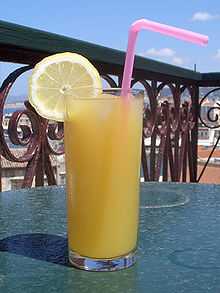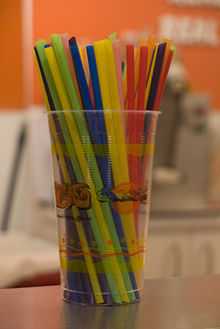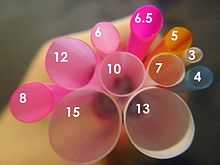Drinking straw



A drinking straw is a short tube intended for transferring a beverage from its container to the mouth of the drinker. A thin tube of plastic (such as polypropylene and polystyrene) or other material, straight or with an angle-adjustable bellows segment, it is employed by being held with one end in the mouth and another end in the drink. Muscular action reduces air pressure in the mouth and above the liquid in the straw, whereupon atmospheric pressure forces the beverage up the straw.
History
The first known straws were made by the Sumerians, and were used for drinking beer,[1] probably to avoid the solid byproducts of fermentation that sink to the bottom. The oldest drinking straw in existence, found in a Sumerian tomb dated 3,000 B.C.E., was a gold tube inlaid with the precious blue stone lapis lazuli.[1] Argentines and their neighbors used a similar metallic device called a bombilla, that acts as both a straw and sieve for drinking mate tea for hundreds of years.[1]
In the 1800s, the rye grass straw came into fashion because it was cheap and soft, but it had an unfortunate tendency to turn to mush in liquid.[1] To address these shortcomings, Marvin C. Stone patented the modern drinking straw, made of paper, in 1888.[2] He came upon the idea while drinking a mint julep on a hot day in Washington, D.C.; the taste of the rye was mixing with the drink and giving it a grassy taste, which he found unsatisfactory.[1] He wound paper around a pencil to make a thin tube, slid out the pencil from one end, and applied glue between the strips.[1] He later refined it by building a machine that would coat the outside of the paper with wax to hold it together, so the glue wouldn't dissolve in bourbon.[1]
Early paper straws had a narrow bore similar to that of the grass stems then in common use. It was common to use two of them, to reduce the effort needed to take each sip. (The cocktail straw, which is sometimes used in pairs, may be derived from such early straws.) Modern plastic straws are made with a larger bore, and only one is needed for ease of drinking.
Health and environment
One particular advantage of using a straw when drinking is the reduction of tooth decay. Many soft drinks have acidic properties, and using a straw reduces the liquid contact with the teeth, particularly the anterior teeth, reducing tooth decay and the risk of cavities.[3][4]
Drinking straws are a form of plastic consumption when made, and become a landfill item when discarded. Made from polypropylene, they are strong and can be reused rather than recycled into other products. Waste straws in Uganda are collected from beer and soft drink depots, cleaned, and woven into mats for picnics and prayers or joined to form bags.[5]
Types
- A basic drinking straw is straight for the full length.
- A bendable straw or "bendy straw" (known in the industry as an "articulated straw") has a concertina-type hinge near the top for convenience. This variation was invented by Joseph Friedman in 1937.[1][6]
- Candy straws, such as licorice straws (or lico-straws), are made from some type of chewy candy.
- A recent addition to the straw family is the cereal straw, such as the ones made by Kellogg's.
- Special "color-changer" straws change color when cold (or hot) liquid passes through them. At some restaurants, frozen beverages like slush or frappes are served with color changing straws. Many of these are larger in diameter than typical straws to aid in drinking the thicker beverages.
- A "crazy straw" is hard, transparent or translucent plastic and has a number of twists and turns at the top. When liquid is sucked through the straw, it quickly flows through the winding path, creating a mildly amusing spectacle, popular with children.[7]
- Extendo-straws come in small plastic wrappings like miniature straws, but can extend to reach the bottom of the carton.
- Flavor straws are a form of drinking straw with a flavoring included, designed to make drinking milk more pleasant for children. They first marketed in the United States in 1956 as Flav-R-Straws.[8] In recent years, newer variations of the original idea have been resurrected in forms such as Sipahhs, and Magic Milk Straws that contain hundreds of flavored pellets encased within a stiff plastic straw.
- A miniature straw is often attached to a drink box.
- Polypropylene is becoming favored over polystyrene for manufacturing plastic drinking straws as polystyrene is brittle and tends to crack easily. Polystyrene is also denser than water, causing straws to sink when placed into beverages. Polypropylene straws, by contrast, are much more durable and do not sink.
- Silicone is a newer material used in drinking straws. Silicone straws are marketed for their freezability, invulnerability to cracking or peeling, and insulation for hot and cold drinks.
- Metal straws, very popular among campers, are made from stainless steel, aluminum, and even titanium.
- "Sanitary" straws are individually wrapped to avoid contamination. Straws were originally marketed as a means for people to reduce the risk of contracting an illness from improperly washed containers, glasses, or cups.
- A spoon straw features a cut-away shape at one end that functions as a miniature spoon. It is intended for slush drinks and milkshakes. Their original purpose was to avoid ice clogging up the submerged end of the straw.[9]
- A wide straw is used for sipping bubble tea. The larger diameter is necessary to accommodate the drink's characteristic tapioca pearls, and can also be used for stirring. The tip of these straws are sometimes cut at an angle creating a point. This allows the straw to puncture the plastic cover of the cup.
Nicholson Baker's novel, The Mezzanine (1988), includes a detailed discussion of various types of drinking straws experienced by the narrator and their relative merits.
Notes
- ↑ 1.0 1.1 1.2 1.3 1.4 1.5 1.6 1.7 "The Amazing History and the Strange Invention of the Bendy Straw", Derek Thompson, The Atlantic, November 22, 2011.
- ↑ US 375962, Stone, Marvin, "Artificial straw", issued 1888
- ↑ Saved By A Straw? Sipping Soft Drinks And Other Beverages Reduces Risk Of Decay
- ↑ "Sipping Soda Through a Straw May Cut Cavities". Webmd.com. 2005-06-17. Retrieved 2012-06-13.
- ↑ "Strong, durable and re-usable bags made from waste drinking straws in Uganda". Strawbags. Retrieved 2012-06-13.
- ↑ Friedman and the Flexible Straw
- ↑
- ↑ Milk plant monthly, Volume 45, p. 68 (1956), quote: "New Flavored Straws For Use in Milk Drinks [...] A new type of straw with built-in flavor for use with milk drinks has been introduced by Flav-R Straws, Inc."
- ↑ "Drinking Straw Explained"
External links
| Look up drinking straw in Wiktionary, the free dictionary. |
| Wikimedia Commons has media related to Drinking straw. |
| ||||||||||||||||||||||||||||||
